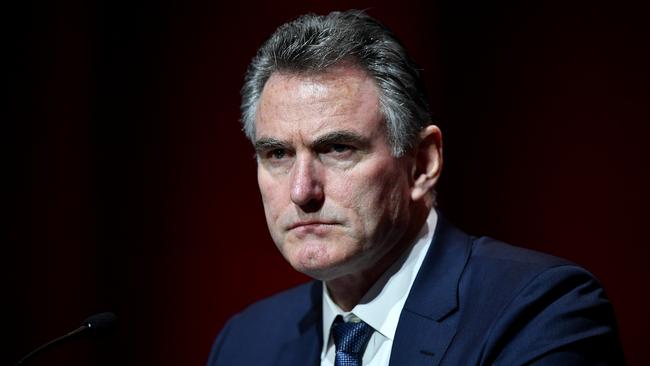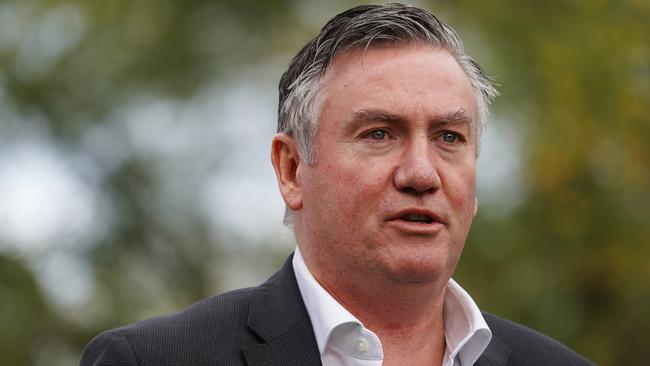How $600m loan deal saved AFL
The scale of the crisis faced by the football code was apparent to everyone.

When a much-loved sport like the AFL shrinks to almost nothing in a matter of days, the idea of the code signing a loan facility worth up to $600m with two major banks seems fanciful.
On Monday, however, NAB and ANZ agreed on the terms, prompting new NAB chief Ross McEwan to pen a celebratory message to all staff, with the AFL’s press release attached.
“We are delighted to help the AFL, as we are all our customers,” McEwan said. “We are here to help them through to the other side of this crisis.”
One of the great ironies of the AFL package is that the rescue was ultimately overseen by two New Zealand-born bank CEOs who have a greater connection to the All Blacks rugby union team than to the uniquely Australian football code.

While McEwan and his ANZ counterpart Shayne Elliott have bragging rights, each bank dedicated a small team from their corporate and institutional divisions to the task.
The lead banker at NAB was institutional boss David Gall, with Mark Whelan his counterpart at ANZ. The AFL, for its part, had a team of key executives working on the debt deal. It included chief executive Gillon McLachlan, chief financial officer Travis Auld, and the league’s general manager of infrastructure and major projects, Ray Gunston, a former Tatts chief financial officer.
Some of the nation’s top legal talent, including Arnold Bloch Leibler partner Leon Zwier and Melbourne commercial silk Philip Crutchfield, were called in to support the executives.
A “war cabinet” was also convened to lead the code’s response to the coronavirus pandemic.
The group comprised four AFL commissioners and an equal number of club presidents, some of whom are more accustomed to division than a unifying purpose, particularly when pursuing their clubs’ interests.
The commissioners were chairman and former Wesfarmers chief executive Richard Goyder, AFL chief McLachlan, Seek co-founder and venture capitalist Paul Bassat and investment banker Robin Bishop.

With four club presidents at the table, there was no need for the AFL to communicate individually with each club.
The presidents included Eddie McGuire (Collingwood), lawyer Peter Gordon (Western Bulldogs), Moelis Australia managing director and head of investment banking Andrew Pridham (Sydney Swans) and former Victorian premier Jeff Kennett (Hawthorn).

The scale of the crisis faced by the code was apparent to everyone. On Sunday, March 22, after the completion of a single round, the game’s administrators had no option but to shut down the AFL.
State borders were closing due to the pandemic and it simply was not possible to proceed with a national competition.
“To say this is the most serious threat to our game in 100 years is an understatement,” McLachlan said gravely.
“It is unprecedented in its impact. It is unprecedented in the impact it is having on our game and the wider community. As a community and as a code, we all need to take the unprecedented and required actions to get through this together.”
The AFL resolved to put the competition on hold until at least May 31, and the game’s peak body and the clubs proceeded rapidly with a swingeing program of cost cuts. About 80 per cent of staff were stood down.
As one source put it: “The first task was to ascertain the size of the problem, and the calculation went like this: ‘We have this much in costs and no revenue.’ So we adjusted the costs, and the size of the problem became the lower figure for costs, minus the revenue. It was still a big problem.”
The clubs, as well, were bleeding heavily, creating a further set of challenges for directors who were mindful of their legal obligation to avoid insolvent trading, even if the operation of the law had been temporarily suspended.
The structure chosen for the rescue was designed to neutralise the issue by creating a “safe harbour” for directors to continue in their roles. If the clubs choose to become supported entities, their debts will, in effect, be guaranteed by the AFL.
The code now has three sources of funding. It went into the crisis with about $100m in cash, and it now has access to a facility that is partly unsecured and partly secured.
The security is an extended leasehold interest over the Marvel Stadium in Melbourne, which was bought by the AFL in 2016.
On Monday, McEwan participated in an online business conference, taking questions about supporting NAB’s customers through the crisis.
He spoke generically, without mentioning the AFL debt deal.
“Well, certainly for us we’re going to be looking to support our existing customers,” the NAB boss said.
“You’d have to, I think, look back and say: ‘Was the business a successful business up until two weeks ago?’ And then back up from there.”
The AFL source put it more simply: the AFL and the clubs, he said, had to massively reduce their costs; the players had to take a huge pay cut; and new funding had to be obtained.
“That’s all been done in a week,” he said.
“There’s still a massive amount of work to do, but so far it’s been ‘all for one and one for all’.”



To join the conversation, please log in. Don't have an account? Register
Join the conversation, you are commenting as Logout